As an avid equestrian myself, I’ve noticed this quirky behavior plenty of times and have always wondered what causes it.
Well today, I’m excited to share some insights into this horsey phenomenon with all my fellow horse lovers out there!
The short answer is: horses circle for a variety of reasons, usually related to getting comfortable, expressing emotions, or responding to training cues.
Now let me tell you a funny little story about how I first started noticing horses circling.
When I was a kid, I used to take riding lessons at a local barn called Oakwood Stables.
There was this one lesson horse named Cocoa, a sweet-natured brown mare, who would always start walking in tight little circles while we were tacking up.
At first I thought she was just impatient to start the lesson and wanted to get moving.
But then I noticed she only did it when we put the saddle on, not when we were brushing her or putting on the bridle.
It took me a while to realize she was circling because the saddle was uncomfortable and she was trying to adjust it!
I remember one day the saddle slipped to the side while I was riding, and I realized it was too wide for Cocoa’s narrow frame.
Once we got a properly fitted saddle, no more circles from Cocoa during tacking up.
That’s when the lightbulb went off in my young horse-obsessed brain that circling must be some type of communication from the horse. Pretty cool right?
Table of Contents
Why Horses Naturally Circle?
Horses are natural wanderers and grazers.
In the wild, they roam for miles each day in search of food and water. As prey animals, they also instinctively circle their families and herds to keep watch for predators.
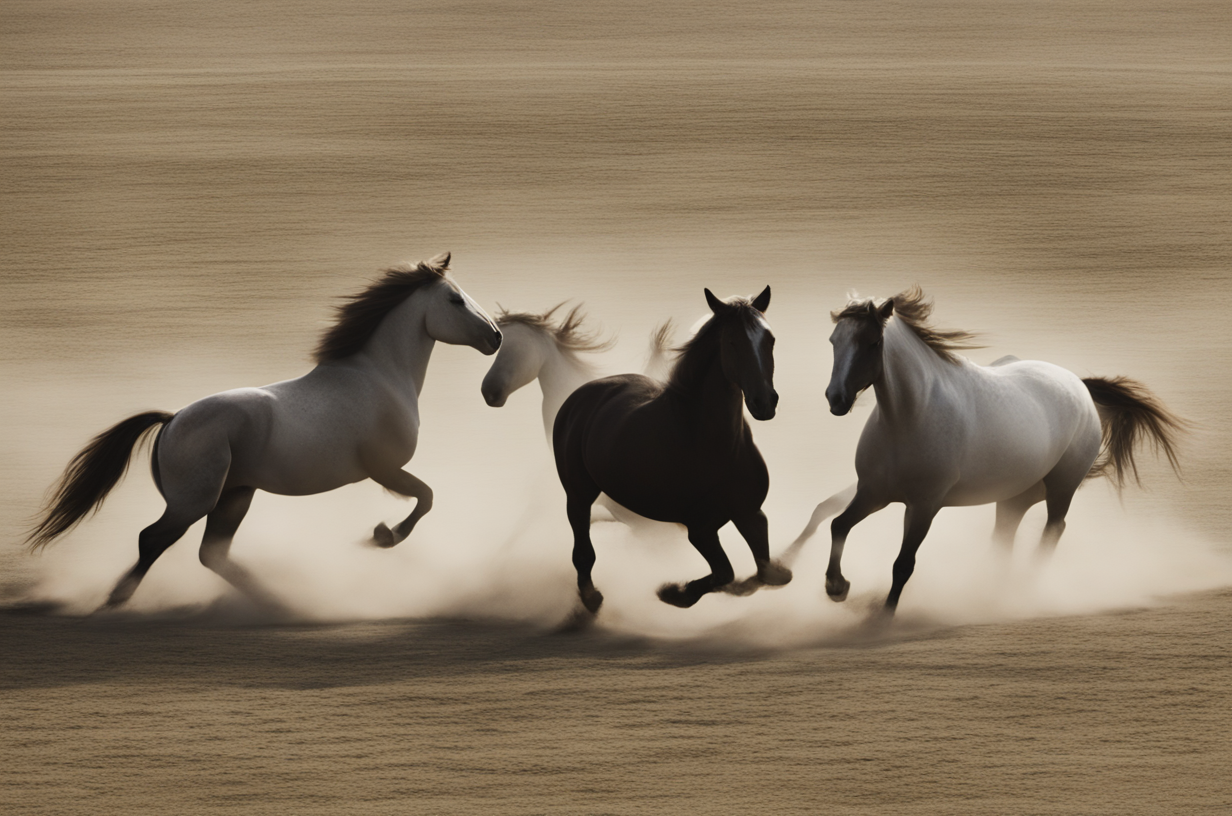
I’ve witnessed this firsthand on a riding trip in Arizona. We came across a small herd of wild mustangs in the desert.
While most of the herd grazed, one or two horses would continually walk a large loop around the group’s perimeter.
Their head was up, eyes and ears alert for any potential danger. If something caught their attention, the lookout horses would release a high-pitched neigh to signal the herd.
It was amazing to see their natural circling behavior for vigilance and protection. This just goes to show that circling behavior is built right into horses’ DNA!
Domestic horses retain this deeply ingrained tendency to circle their surroundings.
Turn a horse loose in a pasture or round pen, and they will trot or canter along the fence line, tracing a path around the perimeter.
I like to do groundwork with horses free in a round pen, and they almost always circle on their own at first as they check out the new space.
Once they feel comfortable, I can ask them to change direction or come to the center.
But initially, they naturally gravitate toward that circular wandering pattern. It provides them security through awareness of their environment.
Circling for Comfort
One of the most common reasons horses circle is to get comfortable.
Have you ever seen a dog or cat go round and round before settling into a nap?
Horses do the same thing! Before lying down to rest, they will “nest” – walking in decreasing circles while smoothing out the ground.
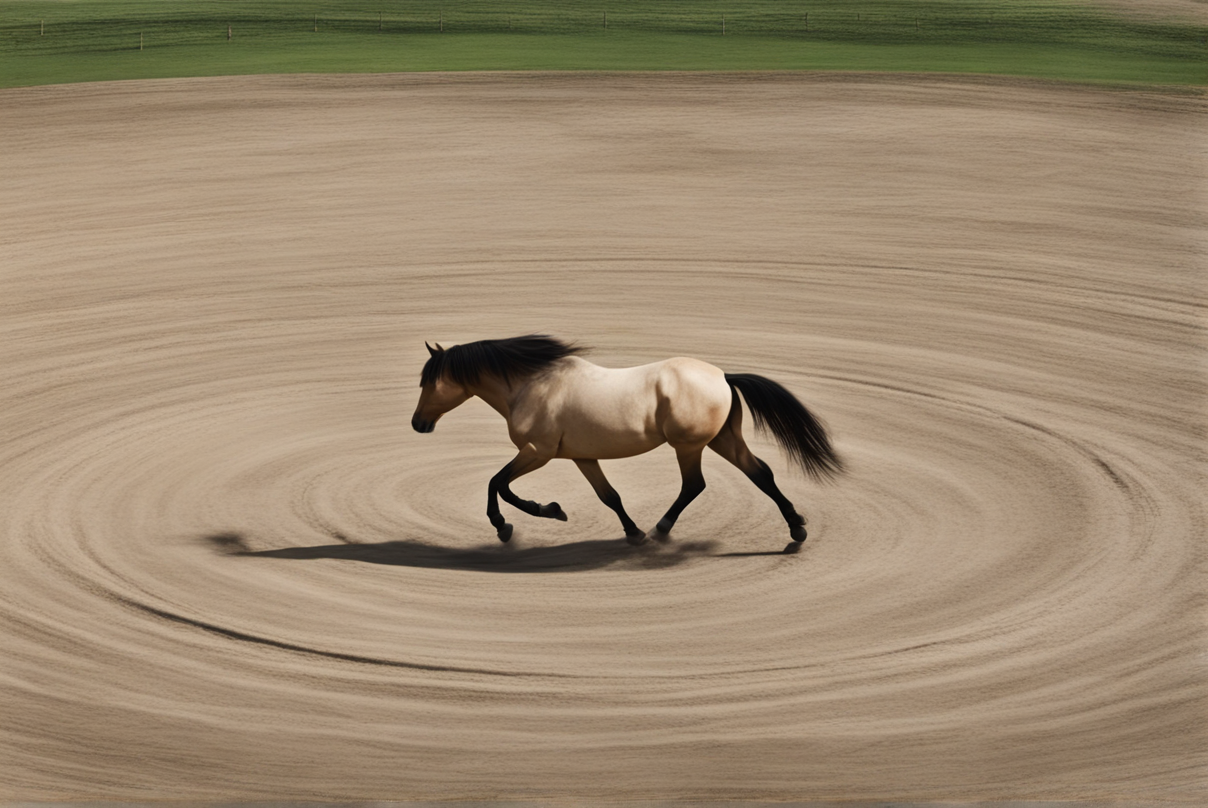
This circling lets them check their surroundings and make sure the area is safe before lying down.
I once cared for a pony who circled nearly 30 times before finally dropping and rolling on his side for a nap. It’s an instinct that goes back to their prey animal needs for security and caution.
Horses may also circle while being groomed, saddled, or even when mounted.
This helps them adjust and find comfort in the unfamiliar feeling of tack and a rider on their back. I remember the first time I put a saddle on my young gelding Louie.
As I gently placed it on his back and secured the girth, he immediately started walking in tiny circles next to me.
He wasn’t being bad or trying to get away – he simply felt uncomfortable with the new pressure on his back and circled to cope with the sensation.
After a few sessions, he became accustomed to the feeling and the circling stopped. Like nibbling an itch, circling helps satisfy horses’ need to address new sensations on their body.
I often see horses circle when mounting as well, especially if the rider is off balance or rocks too much in the stirrups.
The motion of the rider climbing aboard and getting situated can cause discomfort, so the horse reacts instinctively by moving their feet in circles.
As a rider, I pay close attention to mounting carefully, keeping my weight centered to minimize unnecessary circling.
But it’s still a common phenomenon, especially among green horses or distracted riders with less finesse in the saddle!
Emotional Expression
Since horses can’t speak our language, circling is one way they communicate their emotions and energy level.
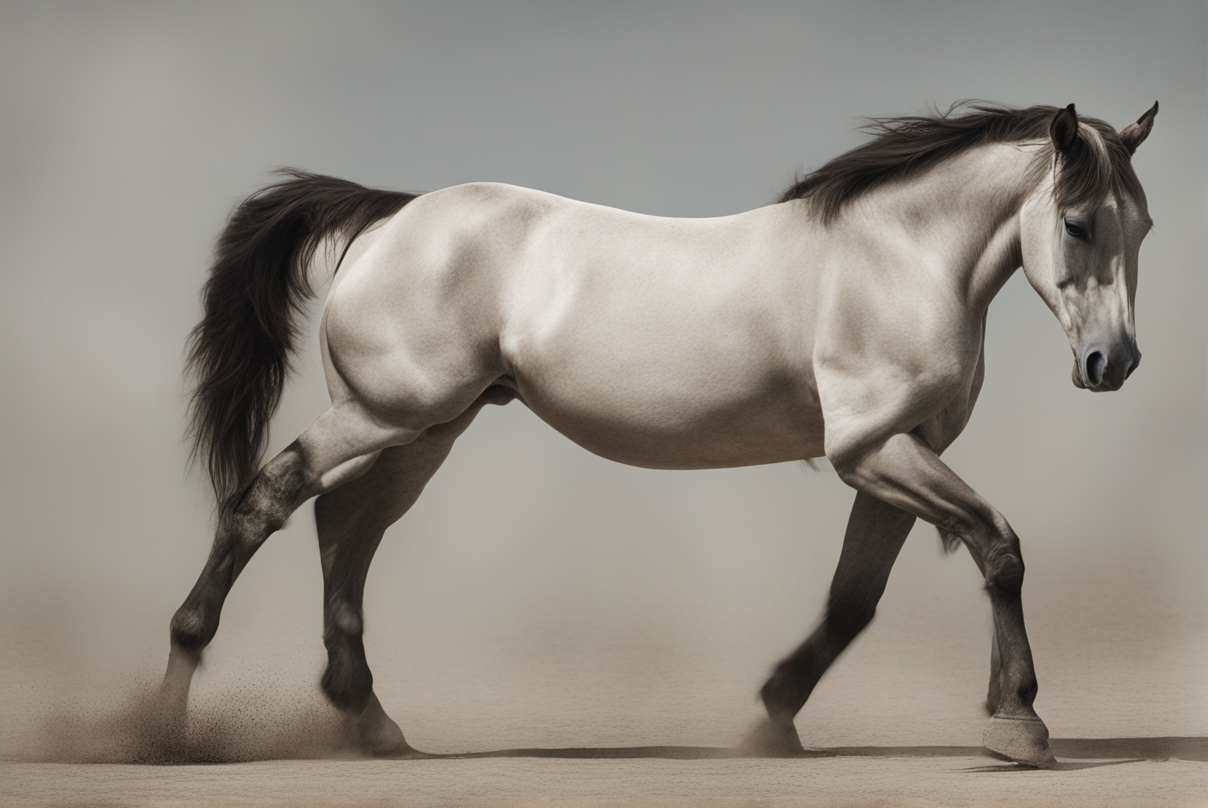
When a horse feels anxious, excited, or frustrated, they may circle to let it out.
It’s like a kid who can’t sit still in their seat! High-energy horses often circle while waiting to be ridden as a way to release pent-up anticipation.
My horse Louie would sometimes jog in restless circles if he had to wait his turn during a crowded summer riding camp.
Letting him circle helped dissipate that nervous energy so he could focus once it was time for his lesson. If your horse starts emotional circling, let them get their ya-yas out before asking them to focus on work.
I also see a lot of circling behavior among horses turned out together in a pasture. If two horses get in an argument over food or space, you’ll often see them circle one another in a standoff.
Ears pinned back, teeth bared, nostrils flaring – they circle to show emotion and establish rank in the herd.
Of course I try not to let disagreements escalate to that level! But circling seems to be an instinctive way for horses to display their feelings.
Boredom is another emotion that can prompt circling. Horses are active, inquisitive animals that need mental stimulation.
Tying a horse in cross ties for too long or keeping them alone in a stall day after day can cause boredom circling.
I knew a pony who lived alone in a small paddock with little interaction. He would circle for hours on end along the fence line, restless and searching for entertainment.
As soon as his owner started providing him with a companion, room to roam, and enrichment activities, the constant circling stopped.
So be sure to provide plenty of equine mental stimulation to avoid boredom-induced loops!
Training Cues
Finally, some circling behavior in horses relates to training. Circles are a fundamental movement we teach horses for control and responsiveness.
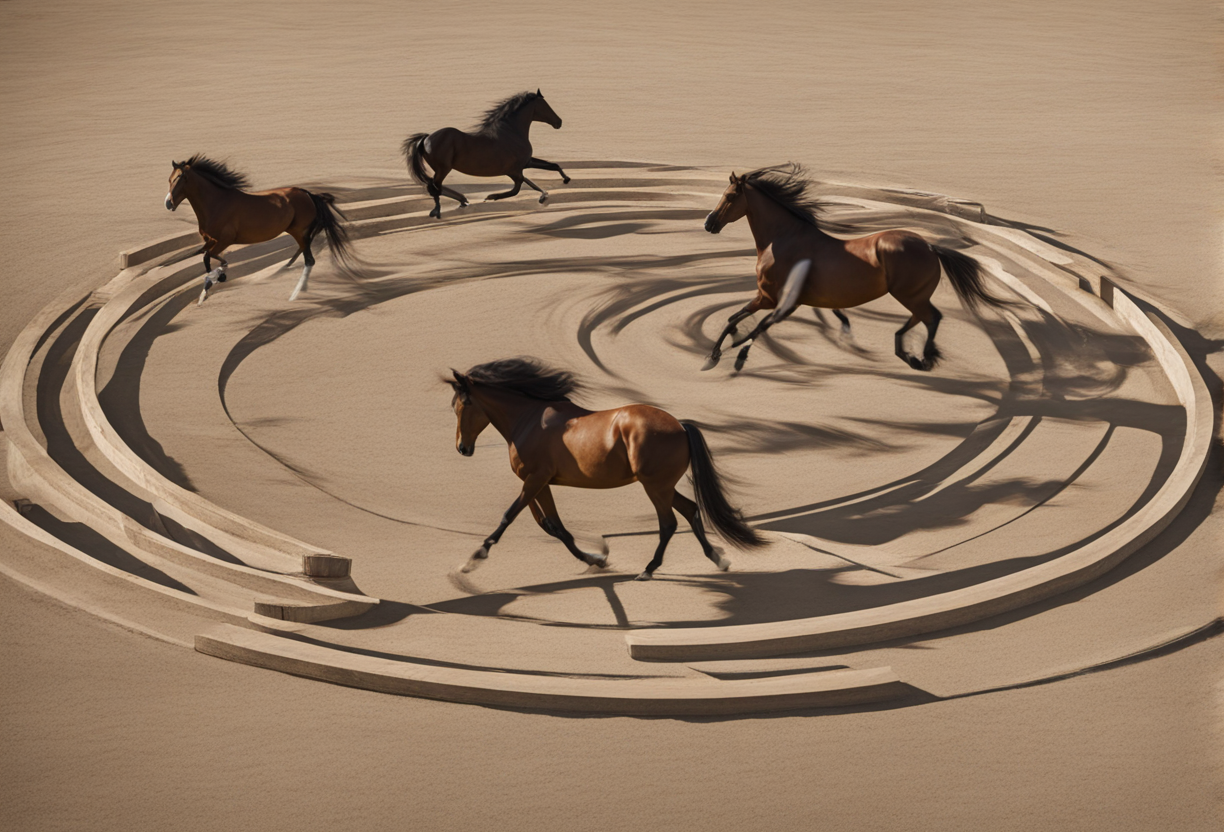
Trainers use cues like inside leg pressure to ask the horse to bend around the rider’s inside leg and walk a circle.
I remember learning to apply inside leg in my early riding lessons. Keeping contact with the rein, I would gently squeeze my inside calf against the horse’s side to initiate a turn.
Timing the release as the horse rounded their body into a smooth circle took lots of practice! We also use circles to supple and warm up horses before starting more complex flatwork or jumping.
Lunging and round pen work are other ways we use the circle to train horses. Free lunging encourages the horse to move outward in a circle around the handler in the middle.
It’s useful for assessing soundness, building fitness, and establishing rhythm.
Round pen work employs the same circular pattern, but with more handler guidance like changing directions or decreasing the size of the circle.
These techniques tap into the horse’s natural circling tendencies for focused training.
The key is noticing when circling originates from the horse versus the rider.
If your horse frequently circles without cues, paying attention to the timing and context can help decipher the reason why.
But responsive circling when you apply the proper leg, seat, and rein aids means your training is paying off!
Tips for Managing Circling
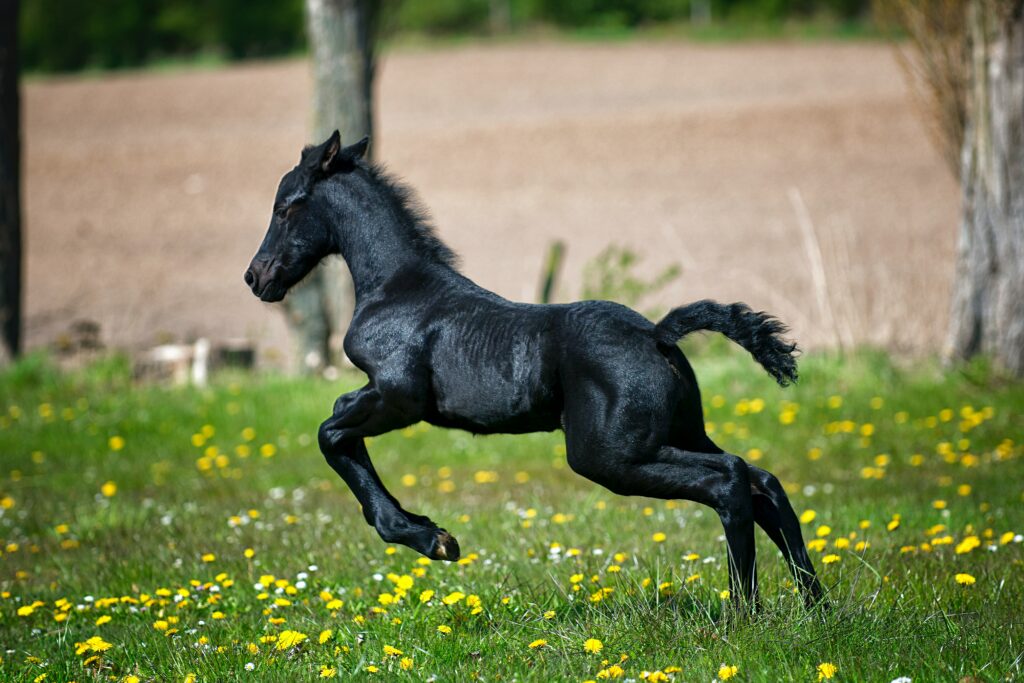
- Rule out pain – Make sure ill-fitting tack isn’t causing discomfort
- Check the arena – Deep footprints or uneven footing can cause a horse to circle
- Consider boredom – Add more stimulating exercises to keep them focused
- Try lunging first – Letting a horse burn off steam may prevent circling under saddle
- Work on transitions – Frequent changes of gait can improve responsiveness
- Ride large circles – Circles with a wider diameter are easier for horses to stay straight
- Use half halts – Remind the horse to rebalance focus with a firming and release of your core
- Develop lateral flexions – Suppling the horse side to side enhances bend and balance
Well, I hope this gives you some insight on the reasons your horse might be going around in circles! It’s one of those quirky horse behaviors that makes them so darn interesting.
If you ever catch your four-legged friend making loop-de-loops, remember it’s just their way of communicating.
Be sure to rule out pain first, then consider what message they might be trying to send you. Let me know in the comments below if you have any other circling stories or tips! Until next time, happy trails!
FAQs
Is it normal for horses to go in circles?
Going in circles is a natural behavior for horses, and it can serve a variety of purposes, such as communication and protection.
In addition, going in circles is a common maneuver in horseback riding, and it’s used to control the horse’s movement.
In general, it’s normal for horses to go in circles, and it’s not usually a cause for concern.
Can horses get dizzy from going in circles?
Horses might get dizzy from going in circles if they’re forced to do it for an extended period of time, especially if they’re not used to it.
However, in general, horses are able to tolerate going in circles much better than humans can. They have a well-developed sense of balance and they’re used to moving around quickly, so they’re less likely to get dizzy.
Can going in circles be harmful to a horse?
Going in circles can be harmful to a horse if it’s forced to do it for an extended period of time or if it’s not in good physical condition.
If a horse is not properly warmed up or if it’s not used to going in circles, it might strain its muscles or put extra stress on its joints.
In addition, if a horse is forced to go in circles at a high speed or if it’s not being ridden properly, it might lose its balance and fall.
In general, it’s important to make sure that horses are in good physical condition and that they’re not being pushed beyond their limits when going in circles.